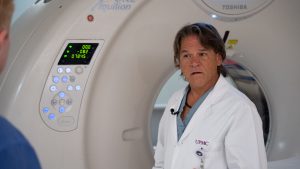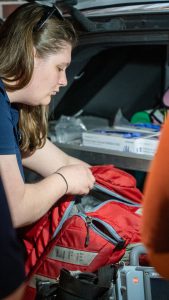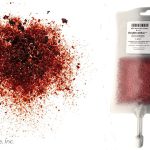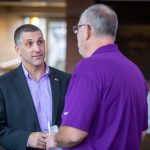Dr. Steve Zanders can’t stop looking at his Apple Watch. He knows that some notifications come with the opportunity to save a life.
Whether he’s hiking the Appalachian Mountains or simply sitting at home, modern technology gives him a real-time glimpse into stroke cases happening across the seven hospitals in UPMC’s central Pennsylvania region.
An artificial intelligence program built into the software of the CT scanner alerts providers of a probable bleed or clot in the brain and alerts the stroke care teams often before the patient is off the CT scan table.
As medical director for neurocritical care, Dr. Zanders responds to each notification he receives by carefully conducting an orchestra of neurosurgeons, stroke coordinators, emergency medical services teams, emergency department personnel, vascular neurology experts from Pittsburgh, and others to make sure the diagnosis is accurate and that the case is responded to appropriately.

Steve Zanders, D.O., explains how artificial intelligence technology supports stroke care across UPMC hospitals in the central Pennsylvania region.
“At each of our hospitals, artificial intelligence gives us the ability to review cases in real-time, while a patient is still inside the CT scanner,” Dr. Zanders said. “It helps us differentiate between the two types of stroke and initiates a conversation between all the right teams to make sure patients quickly get the care they need.”
With almost two million estimated neurons on the line each minute someone suffers from a stroke, there’s no time to waste. If the stroke is ischemic, or a clogged artery in the brain, physicians might use thrombolytic medications to ‘bust’ the clot, if given within a few hours since the patient started to experience symptoms. If thrombectomy, or surgical removal of a blood clot from the brain, is needed, the team can have a STATMedEvac helicopter or Community Life Team ambulance ready to transport that patient to UPMC Harrisburg (if they aren’t already there) before the patient even leaves the scanner.
If the stroke is hemorrhagic, or a “brain bleed”, the treatment approach is different and may require medications to aid the body’s clotting processes and reduce blood pressure, or in some cases, surgery.
“The artificial intelligence doesn’t replace the expertise of our care teams,” Dr. Zanders said. “Rather, it provides an initial assessment of the patient and then quickly notifies our team so we can confirm the diagnosis and work quickly to develop the most effective treatment plan.”
As important as the work of care teams is, responding to a stroke in a timely manner begins with the community. When a layperson calls 911 with a suspected stroke case, a chain reaction begins that loops together emergency medical services and hospital teams to coordinate care.

Lacey McGuire, emergency medical technician with UPMC Community LifeTeam, shows some of the equipment the team uses to respond to possible stroke patients.
“EMS’ role can’t be understated,” Dr. Zanders said. “They monitor and support patients during transport and are in constant contact with our in-hospital teams to assess the patient and get them to the appropriate destination for care.”
If a person suspects someone is having a stroke, they should consider B.E. F.A.S.T:
- Behavior and Balance: Has the person had a change in behavior or lost their balance?
- Eyes: Ask the person if their vision has changed. Are their eyes moving abnormally or is gaze fixed?
- Face drooping: Ask the person to smile. Is one side of the face drooping?
- Arm weakness: Ask the person to raise both arms. Is one arm weak or numb?
- Speech trouble: Ask the person to repeat a simple sentence like “the sky is blue.” Is speech slurred or hard to understand?
- Time or Terrible headache: Is the person experiencing a terrible headache, especially the worst they’ve ever experienced? When it comes to stroke, time is crucial. If someone is experiencing any of these symptoms, call 9-1-1 immediately—even if the symptoms start to fade.
Working together, members of the community, emergency medical services and hospital care teams ensure that people suffering from a stroke get on the road to recovery as soon as possible.









